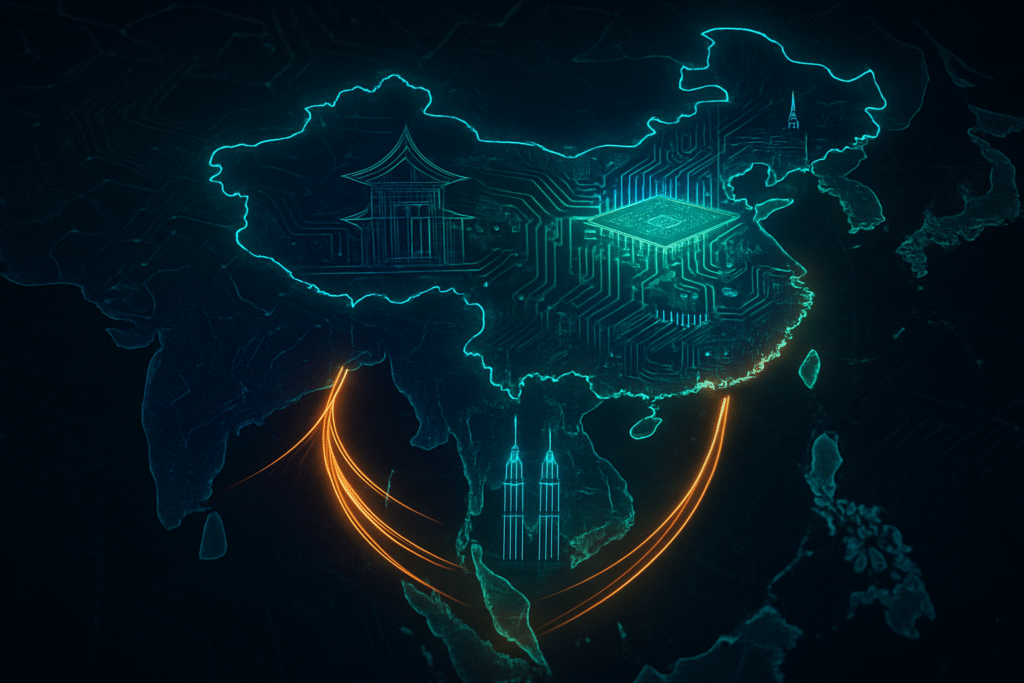
KUALA LUMPUR, MALAYSIA – In a significant recalibration of global supply chains and technological hubs, Malaysia is rapidly becoming a preferred destination for Chinese tech companies seeking to navigate an increasingly complex international trade landscape. This strategic exodus, which has seen a notable acceleration through 2024 and is projected to intensify into late 2025, is primarily propelled by the persistent shadow of US tariffs and the newfound ease of bilateral travel, among other compelling factors. The immediate implications are profound, promising an economic uplift and technological infusion for Malaysia, while offering Chinese firms a vital pathway to de-risk operations and sustain global market access.
The trend underscores a broader "China-plus-one" strategy, where Chinese enterprises are actively diversifying their manufacturing and operational footprints beyond their home borders. This is not merely a tactical retreat but a strategic repositioning, aimed at fostering resilience against geopolitical pressures and tapping into new growth markets. As global economies brace for continued trade realignments, Malaysia's emergence as a key player in high-tech manufacturing and digital infrastructure is reshaping the competitive dynamics of the Asian technology sector.
A New Nexus: Unpacking the Drivers and Dynamics of Chinese Tech Migration
The migration of Chinese tech companies to Malaysia is not a spontaneous occurrence but a meticulously planned strategic maneuver, underpinned by a convergence of economic pressures and facilitating policies. At the forefront of these drivers are the escalating US-China trade tensions and the practical advantage of recent visa-free travel agreements.
The specter of US tariffs, potentially reaching as high as 60% on certain Chinese imports, particularly in critical sectors like semiconductors, electric vehicles (EVs), and batteries, has been a primary catalyst. These punitive measures, coupled with US administration restrictions on advanced chip sales to China, have compelled Chinese firms to re-evaluate and restructure their global supply chains. By establishing operations in Malaysia, companies aim to circumvent these tariffs, ensuring their products remain competitive in international markets. Malaysia's long-standing and robust semiconductor ecosystem, which accounts for 13% of the global market for chip packaging, assembly, and testing, presents a highly attractive alternative to traditional manufacturing hubs. However, Malaysian authorities have been clear, advising against mere "rebadging" of products and emphasizing the need for genuine investment and integration into the local economy.
Adding to the strategic allure is the implementation of visa-free travel between China and Malaysia, effective July 17, 2025, allowing mutual visa exemptions for stays up to 30 days. This policy significantly streamlines business travel, facilitating easier exploration of investment opportunities, due diligence, and on-the-ground management for Chinese executives and technical teams. This practical ease of movement reduces operational friction and encourages more direct engagement and investment.
Beyond these immediate drivers, Malaysia offers a compelling intrinsic value proposition. Its strategic location at the heart of ASEAN provides unparalleled access to a burgeoning Southeast Asian consumer market and critical global trade routes. The country boasts an established high-tech manufacturing infrastructure, particularly in semiconductors, with a 50-year history. The Malaysian government actively courts foreign direct investment (FDI) through a suite of incentives, including "Pioneer Status" (offering significant income tax exemptions) and "Investment Tax Allowance" (ITA). Additionally, the "Malaysia Digital" (MD) status provides tax benefits for technology and digital services. Malaysia's advanced logistics, expanding 5G networks, and burgeoning data center industry, particularly in Johor, further solidify its appeal. This comprehensive package of policy support, infrastructure, and skilled workforce differentiates Malaysia from previous relocation trends, which might have been driven solely by lower labor costs, emphasizing instead a move towards a more sophisticated, resilient, and strategically positioned supply chain.
Reshaping the Corporate Landscape: Beneficiaries and Competitive Shifts
The influx of Chinese tech companies into Malaysia is poised to create a dynamic shift in the competitive landscape, benefiting a range of players while posing new challenges for others. Both Chinese and Malaysian entities stand to gain, but the ripple effects will be felt across the broader tech industry.
Chinese companies like Huawei, BYD (HKG: 1211), Alibaba (NYSE: BABA) (through Lazada), JD.com (HKG: 9618), and TikTok Shop (owned by ByteDance) have already established a significant presence, and many more are expected to follow. These firms benefit by diversifying their manufacturing and supply chains, thereby mitigating the risks associated with US tariffs and export controls. This "China-plus-one" strategy allows them to maintain access to crucial international markets, ensuring continued growth and technological advancement despite geopolitical headwinds. For example, semiconductor manufacturers can leverage Malaysia's established packaging and testing capabilities to bypass restrictions on advanced chip sales, effectively extending their global reach.
For Malaysia, the economic benefits are substantial. The influx of Chinese FDI, which contributed significantly to the RM89.8 billion in approved foreign investments in Q1 2025, is expected to create thousands of skilled jobs and foster technological transfer. Local Malaysian companies, particularly those in the semiconductor, logistics, and digital infrastructure sectors, are likely to see increased demand for their services and potential for partnerships. This competition is also likely to spur innovation among traditionally dominant US and European companies operating in Malaysia, pushing them to enhance their offerings and efficiency. However, there's a critical need for Malaysia to ensure that local small and medium-sized enterprises (SMEs) are genuinely integrated into these new supply chains, rather than merely observing the growth from afar.
The competitive implications for major AI labs and tech companies are also noteworthy. As Chinese firms establish more robust international footprints, they become more formidable global competitors, potentially challenging the market dominance of Western tech giants in emerging markets. This strategic decentralization could lead to a more fragmented global tech ecosystem, where regional hubs gain prominence. While this offers resilience, it also necessitates greater agility and adaptability from all players in navigating diverse regulatory and market environments. The shift also presents a challenge for Malaysia to manage its energy and water resources, as the rapid expansion of data centers, a key area of Chinese investment, has already led to concerns and a potential slowdown in approvals.
Broader Implications: A Shifting Global Tech Tapestry
This migration of Chinese tech companies to Malaysia is more than just a corporate relocation; it signifies a profound recalibration within the broader AI landscape and global supply chains, with wide-ranging implications. It underscores a growing trend towards regionalization and diversification, driven by geopolitical tensions rather than purely economic efficiencies.
The move fits squarely into the narrative of de-risking and supply chain resilience, a dominant theme in global economics since the COVID-19 pandemic and exacerbated by the US-China tech rivalry. By establishing production and R&D hubs in Malaysia, Chinese companies are not just seeking to bypass tariffs but are also building redundancy into their operations, making them less vulnerable to single-point failures or political pressures. This creates a more distributed global manufacturing network, potentially reducing the concentration of high-tech production in any single country.
The impact on global supply chains is significant. Malaysia's role as the world's sixth-largest exporter of semiconductors is set to be further cemented, transforming it into an even more critical node for high-tech components. This could lead to a re-evaluation of logistics routes, investment in port infrastructure, and a greater emphasis on regional trade agreements within ASEAN. However, potential concerns include the risk of Malaysia becoming a "re-export" hub rather than a genuine manufacturing base, a scenario Malaysian authorities are actively trying to prevent by encouraging substantive investment. There are also environmental considerations, as increased industrial activity and data center expansion will place greater demands on energy grids and natural resources.
Comparisons to previous AI milestones and breakthroughs highlight a shift from purely technological advancements to geopolitical-driven strategic maneuvers. While past milestones focused on computational power or algorithmic breakthroughs, this trend reflects how geopolitical forces are shaping the physical location and operational strategies of AI and tech companies. It's a testament to the increasing intertwining of technology, economics, and international relations. The move also highlights Malaysia's growing importance as a neutral ground where companies from different geopolitical spheres can operate, potentially fostering a unique blend of technological influences and innovations.
The Road Ahead: Anticipating Future Developments and Challenges
The strategic relocation of Chinese tech companies to Malaysia is not a fleeting trend but a foundational shift that promises to unfold with several near-term and long-term developments. Experts predict a continued surge in investment, alongside new challenges that will shape the region's technological trajectory.
In the near term, we can expect to see further announcements of Chinese tech companies establishing or expanding operations in Malaysia, particularly in sectors targeted by US tariffs such as advanced manufacturing, electric vehicles, and renewable energy components. The focus will likely be on building out robust supply chain ecosystems that can truly integrate local Malaysian businesses, moving beyond mere assembly to higher-value activities like R&D and design. The new tax incentives under Malaysia's Investment Incentive Framework, set for implementation in Q3 2025, are designed to attract precisely these high-value investments.
Longer term, Malaysia could solidify its position as a regional AI and digital hub, attracting not just manufacturing but also significant R&D capabilities. The burgeoning data center industry in Johor, despite recent slowdowns due to resource concerns, indicates a strong foundation for digital infrastructure growth. Potential applications and use cases on the horizon include enhanced collaboration between Malaysian and Chinese firms on AI-powered solutions, smart manufacturing, and the development of new digital services catering to the ASEAN market. Malaysia's emphasis on a skilled, multilingual workforce is crucial for this evolution.
However, several challenges need to be addressed. Integrating foreign companies with local supply chains effectively, ensuring equitable benefits for Malaysian SMEs, and managing competition from neighboring countries like Indonesia and Vietnam will be paramount. Critical infrastructure limitations, particularly concerning power grid capacity and water resources, have already led to a cautious approach towards data center expansion and will require strategic planning and investment. Furthermore, as US trade blacklists broaden, effective immediately in late 2025, overseas subsidiaries of Chinese firms might face increased scrutiny, potentially disrupting their global strategies and requiring careful navigation by both companies and the Malaysian government.
Experts predict that the success of this strategic pivot will hinge on Malaysia's ability to maintain a stable and attractive investment environment, continue to develop its skilled workforce, and sustainably manage its resources. For Chinese companies, success will depend on their ability to localize, understand regional market needs, and foster genuine partnerships, moving beyond a purely cost-driven approach.
A New Era: Summarizing a Strategic Realignment
The ongoing relocation of Chinese tech companies to Malaysia marks a pivotal moment in the global technology landscape, signaling a strategic realignment driven by geopolitical realities and economic imperatives. This movement is a clear manifestation of the "China-plus-one" strategy, offering Chinese firms a vital avenue to mitigate risks associated with US tariffs and maintain access to international markets. For Malaysia, it represents an unprecedented opportunity for economic growth, technological advancement, and an elevated position within global high-tech supply chains.
The significance of this development in AI history, and indeed in tech history, lies in its demonstration of how geopolitical forces can fundamentally reshape global manufacturing and innovation hubs. It moves beyond purely technological breakthroughs to highlight the strategic importance of geographical diversification and resilience in an interconnected yet fragmented world. This shift underscores the increasing complexity faced by multinational corporations, where operational decisions are as much about political navigation as they are about market economics.
In the coming weeks and months, observers should closely watch for new investment announcements, particularly in high-value sectors, and how effectively Malaysia integrates these foreign operations into its domestic economy. The evolution of policy frameworks in both the US and China, along with Malaysia's ability to address infrastructure challenges, will be crucial determinants of this trend's long-term impact. The unfolding narrative in Malaysia will serve as a critical case study for how nations and corporations adapt to a new era of strategic competition and supply chain resilience.
This content is intended for informational purposes only and represents analysis of current AI developments.
TokenRing AI delivers enterprise-grade solutions for multi-agent AI workflow orchestration, AI-powered development tools, and seamless remote collaboration platforms.
For more information, visit https://www.tokenring.ai/.






